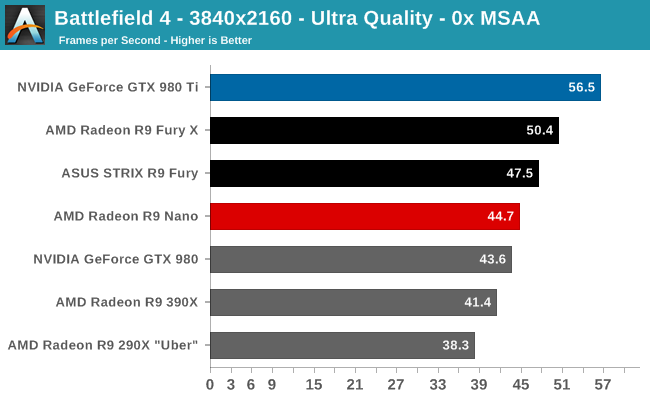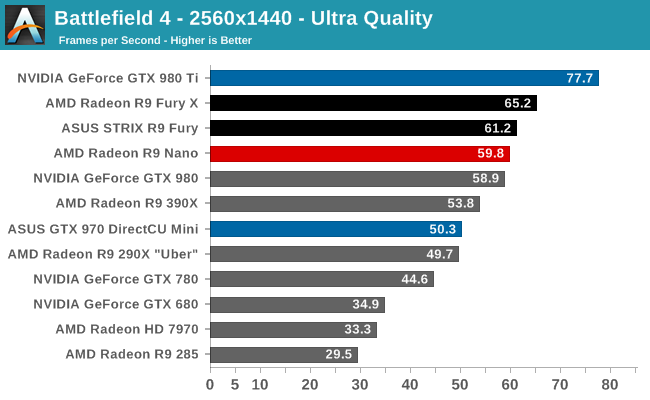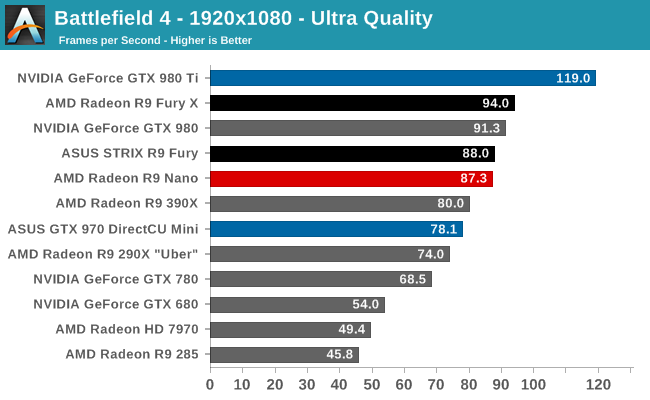The AMD Radeon R9 Nano Review: The Power of Size
by Ryan Smith on September 10, 2015 8:00 AM ESTBattlefield 4
Kicking off our benchmark suite is Battlefield 4, DICE’s 2013 multiplayer military shooter. After a rocky start, Battlefield 4 has since become a challenging game in its own right and a showcase title for low-level graphics APIs. As these benchmarks are from single player mode, based on our experiences our rule of thumb here is that multiplayer framerates will dip to half our single player framerates, which means a card needs to be able to average at least 60fps if it’s to be able to hold up in multiplayer.




Like the other Fiji cards, AMD is promoting the R9 Nano in part on its 4K capabilities. And while we disagree that this card is suitable for 4K gaming based on its sub-Fury performance, we’re including 4K results anyhow to serve as a point of comparison.
In any case Battlefield 4 is often a good indicator of general card performance, and for the R9 Nano this is no exception. What we find is that the R9 Nano trails the other Fury cards in all cases. However to our initial surprise, the R9 Nano sticks rather close to the R9 Fury. The petite powerhouse trails the R9 Fury by only 1-6%, which for the record is a smaller gap than we were expecting.
While the R9 Nano packs a full Fiji GPU, AMD has to pull back on clockspeeds to hit their power targets; in the case of Battlefield 4 this is an average clockspeed of just 879MHz at 2560x1440. Given this we had been expecting the R9 Nano to deliver around 85-90% of the performance of the R9 Fury (and about 80% of the R9 Fury X), based on the assumption that average clockspeeds would be closer to 800MHz. So the fact that the R9 Nano starts off as close to the R9 Fury as it does – even if it’s still trailing it – is a pleasant surprise.
Otherwise with performance still clearly occupying a position as a “3rd tier” Fiji card, I’m not sure if anything about these results should be surprising. On a price/performance basis AMD is not intending to be competitive with other $650 cards, so the R9 Fury X and GTX 980 Ti are of course on the top of the heap. What you get instead is a card that delivers around 90% of R9 Fury X’s performance in BF4 with much less power consumption.
Moving on, compared to the lower power and smaller cards, the R9 Nano is as expected a clean sweep. Demonstrating the virtues of a wide and lower clocked processor’s ability to deliver strong performance without requiring extreme power, everything from the R9 285 to the GTX 980 trails the R9 Nano here. Compared to the GTX 970 Mini in particular, the R9 Nano is 12-26% faster depending on the resolution.
The one potential problem here for the R9 Nano is the GTX 980. Though not a Mini-ITX card, the GTX 980’s power consumption is going to be fairly close to the R9 Nano’s, definitely more so than GTX 970’s. From a power efficiency standpoint it’s the GTX 980 that poses the greatest challenge to the R9 Nano, and while it’s ahead of the GTX 980 in this case at 2560x1440 and higher, it’s a sign that AMD should be worried about what could happen if an NVIDIA partner produced a Mini-ITX GTX 980.










284 Comments
View All Comments
gw74 - Thursday, September 10, 2015 - link
there is no evidence or reason to believe the 3.5GB was anything but an honest mistake, and it was all handled admirably by Nvidia once discovered.You are not the arbiter of what is and is not dead to me, and your condescending attempt to explain its consequences to me is not required.
The point about AMD is that their actions reveal untrustworthiness. Buying a product from someone untrustworthy can have all sorts of negative consequences, whatever the apparent quality or value at the time of purchase.
Pipe down. Have a seat. Have a Diet Coke.
RussianSensation - Thursday, September 10, 2015 - link
"there is no evidence or reason to believe the 3.5GB was anything but an honest mistake, and it was all handled admirably by Nvidia once discovered."Yes, the engineers accidentally designed the card with 3.5GB of VRAM and gimped ROPs. Sure, it was just an accident. Not only that, after it was found out, NV didn't change the specifications for ROPs and VRAM on the boxes of newly produced GTX970 cards. GTX970 doesn't have full speed GDDR5 memory and doesn't have the full stack of ROP performance of GTX980 card. Therefore, it's not a true 4GB GDDR5 card because the last 0.5GB operate at only 28GB/sec which is basically useless.
"and it was all handled admirably by Nvidia once discovered."
NV did absolutely nothing. They showed 0 remorse. It was AIBs that accepted returns. NV didn't provide a return program for existing customers, didn't offer discount coupons for future NV GPUs, they didn't offer a game coupon, they literally did nothing. In fact, they tried to cover it under the rug with PR mouthpieces from sites like PCPerspective how 3.5GB of VRAM doesn't matter.
"The point about AMD is that their actions reveal untrustworthiness. Buying a product from someone untrustworthy can have all sorts of negative consequences, whatever the apparent quality or value at the time of purchase."
What so untrustworthy about AMD's Nano or AMD's graphics cards? The Nano beats GTX970 mini by at least 30%, just like AMD stated. AMD never aimed or claimed to have the Nano being a price/performance king.
gw74 - Thursday, September 10, 2015 - link
This has nothing to do with engineering, the mistakes were in marketing. Nvidia self-evidently showed remorse by admitting and correcting the mistakes and facilitating refunds with retailers. Nvidia don't produce reference 970s, the drop-in card manufacturers do, so which boxes do you mean?For what is untrustworthy try reading my comments.
Oxford Guy - Thursday, September 10, 2015 - link
You should read his rebuttal since clearly you didn't.gw74 - Friday, September 11, 2015 - link
who should read who's rebuttal?RussianSensation - Thursday, September 10, 2015 - link
@gm74,Even if you state that marketing is 100% at fault, which is hard to believe, NV is still responsible for how the product is marketed after the facts came out. It was AIBs that agreed to accept the cards back, not Nvidia. It would be akin to AT&T or Verizon accepting returns of flawed Blackberry phones but Blackberry not offering any refunds directly. NV never offered direct refunds, never issues any game vouchers or discounts as remorse. Stating online that the are sorry does nothing. It's empty PR.
The way professional companies deal with mistakes is completely different than how NV handles it. After the disastrous Bumpgate scandal, the way they treated GTX970 fiasco is shockingly poor.
Mazda after they made a mistake:
"Mazda is offering to buy back most of the 3,551 RX-8 rotary-engine sports cars sold since the July launch because engine power is as much as 5% less than advertised — an important difference to sports car enthusiasts.
Those who tell Mazda they will keep their cars get free scheduled maintenance for the four-year, 50,000-mile warranty period, plus $500."
http://usatoday30.usatoday.com/money/autos/2003-09...
What did Nvidia do in particular for GTX970 owners? Nothing, 0, zilch, nada.
You state that NV isn't responsible for what goes on the marketing boxes of its AIBs? Are you serious. So after NV was caught lying about specifications, did it tell its AIBs to change the specs on their newly printed boxes? If not, they are still lying to consumers and they are OK with AIBs misrepresenting the data.
Kutark - Thursday, September 10, 2015 - link
Im not going to get into the whole debate, but since we're clearly being pedantic here. It was a 4gb card. It absolutely has 4gb of vram. They never advertised it as "4gb (but with .5gb of slower ram!)", so if you want to get on them for that, go for it. But claiming its a 3.5 gb card when it *is* a 4gb card is just as ridiculous as any of the other assertions you're getting on him for making.Oxford Guy - Friday, September 11, 2015 - link
You're not being pedantic. You're being wrong. A lie of omission is a form of lie. 28 GB/s VRAM performance, half that of a midrange card from 2007, is NOT a reasonable expectation for an enthusiast-level card or even any card with DDR5.gw74 - Friday, September 11, 2015 - link
it's not a lie of omission.anubis44 - Thursday, October 8, 2015 - link
Of course it's a misrepresentation. Nobody who reads '4GB' will assume that the last .5GB is so slow that it's essentially necessary to limit game textures to 3.5GB or the game will be suddenly stuttering and the card will be brought to its knees. Give me a break. That's like me marketing a gold bar as 1KG of 'pure gold', but in fact, it's only 750grams of 24K gold, and 250 grams of 10K gold. It's willfully and deliberately deceptive, and if you don't say so, you're complicit in their scam.